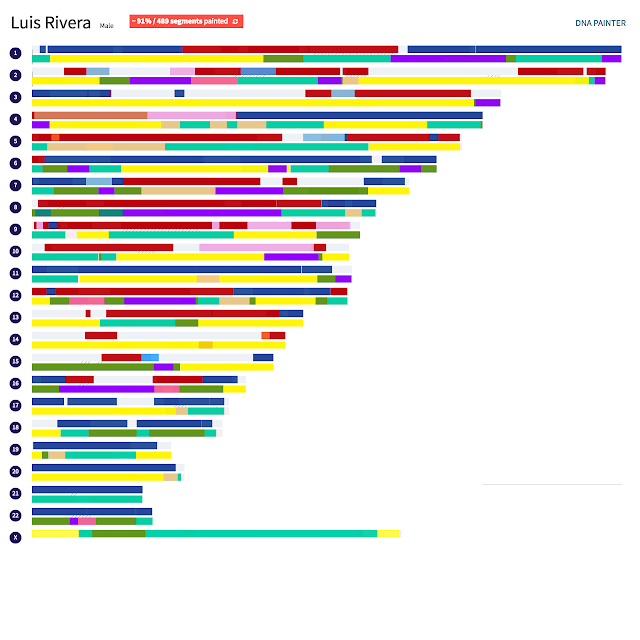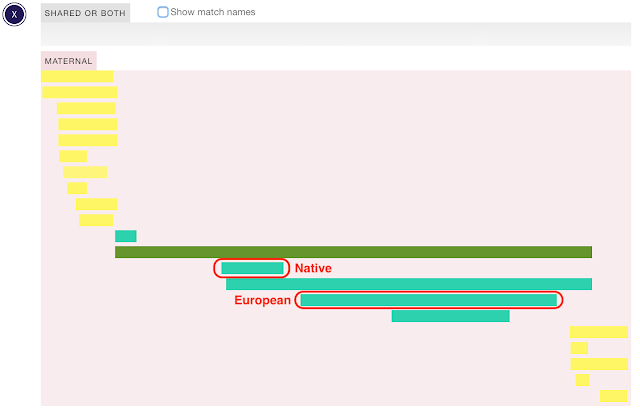What is DNA Painter?
DNA Painter is a tool currently in beta that allows you to take a look at your chromosomes with a bit of a more “microscopic” view into your exact segments and who you match with, also known as chromosome mapping. The tool was created by Jonny Perl and the application won the DNA Innovation Contest for 2018 at RootsTech. Take a look at this video about how he came into creating the tool and its uses!
 |
| DNA Painter Homepage [DNA Painter] |
Taking a look into the homepage you can see what it does, breaks down your DNA into various segments matched to certain ancestors. You have to register for an account in order to use the tool and as always make sure the read the terms and agreements before you create your account.
How does it work?
After creating an account you have to create a profile for yourself (or whomever you will be chromosome mapping for) and that is where you can keep track of your matching segments and cousins. You can create various profiles if you’d like and it has actually been interesting creating ones for my brothers and seeing where they match with certain people and the genes they inherited that I might not have.
You may use your genetic matches from various companies such as 23andme, Gedmatch (transferred results), and/or FamilyTreeDNA to name a few. Unfortunately, if you have AncestryDNA you can not use your segment data unless you have transferred them into Gedmatch and you’d have to hope (or convince that person) to transfer their results as well to see on which chromosome you match. This is important because this is how you begin to establish connections with those cousins and which ancestor(s) in your tree they match. Without the knowledge of the segment, you’d be lost as to where they match you and others.
Seeing as I have mainly used my 23andme information, this is what I’ll mostly be referring to when it comes creating matches on DNA Painter.
If you take a look at how my grandfather and I match you can see that of course there are fairly large chunks. All of these segments below I got from him, so when I map these segments on my DNA Painter profile I can attribute them to him using his name or the name of his parents, my great-grandparents. Remember, these genes can be from any of his parents, so you’d have to use both of their names when you set the segments.
 |
| Me vs. My Maternal Grandfather [Personal 23andMe] |
Under your DNA Painter, every time you want to set new segments or matches you have to click on “Paint a New Match”. There, you can use the start position and end position of each chromosome you match on and upload that into the box (look below).
 |
| “Painting a New Match” [Personal Screenshot] |
The box will look something like this! Depending on how many times you match that person across various segments you can continue to pile on the segments on new lines in the same box. Once you have placed the segments and are ready to save the match, you can decide what color to save the match and what name they can go under. For example, I chose to use my grandfather’s name and so anytime I match someone through him they go under the color yellow and attached to his name. For me, this allows me to see the matches that I have through him.
A Look at Comparisons
By using various of my own cousins, confirmed paper trail matches, and even unknown matches I have begun to map my chromosomes, currently they look like this!
 |
| My DNA Painting |
As you can see there are various colors across my chromosomes and some gray areas. Overall, I have been able to map ~91% of my DNA through 489 segments of mapping. Some of the larger chunks such as yellow (maternal grandfather) and red/blue (paternal matches) are attached to just my great-grandparents while smaller chunks to older ancestors. It’s definitely a work in progress and not so straight forward in the sense that you won’t always have a match to help identify a grey zone or to go back further a generation. It also depends on how much the match knows about their family and how willing they are to talk about shared your genealogy.
 |
| Maternal Chromosome 1 |
This view of my maternal chromosome 1 is an expanded view of the different matches I have, as you can see I have turned off the “show match names” to provide anonymity. However based off the colors you can notice a few things.
 |
| Chromosome 1 – Maternal Great-grandparents |
 |
| Chromosome 1 – Jewish Matches |
As you can see, there are a couple of ways to use DNA Painter. The cool thing is that it technically helps matching others a bit easier since you can deduce where exactly they match you along your family tree a bit quicker, especially if that cousin is unaware of much of their genealogical history or just quiet about your connection.
 |
| Chromosome 8 – Older Brother |
 |
| Chromosome 8- Me |
 |
| Chromosome 8- Younger Brother |
Another step can be adding your ancestral ethnicity information which overlap your segments and you can get a better idea who from your ancestors gave you certain ethnic segments. This however can be a harder task for those of us who have choppy pieces inherited from our ancestors which aren’t inherited in longer pieces and we might have no idea exactly who they are from. However, if you take the time and with a bit of luck you might be able to piece together where some of these pieces came from.
 |
| X-Chromosome Inheritance |
Conclusions
